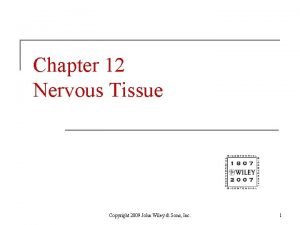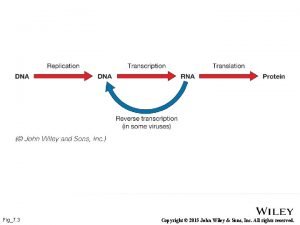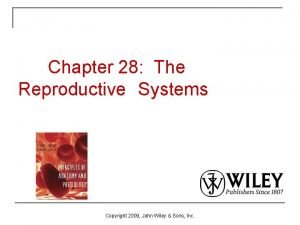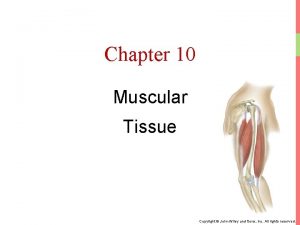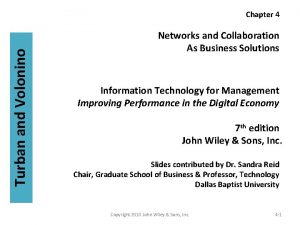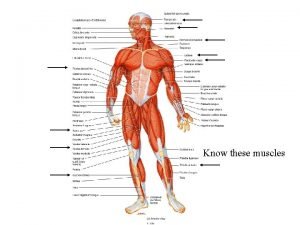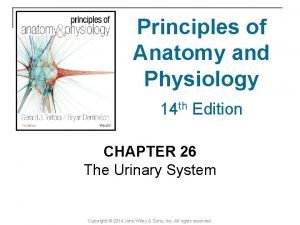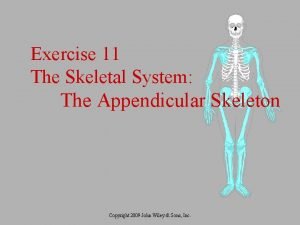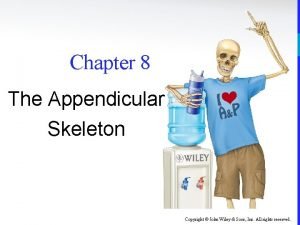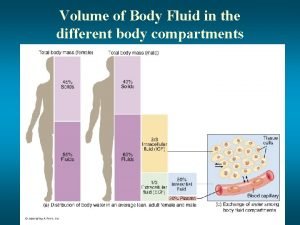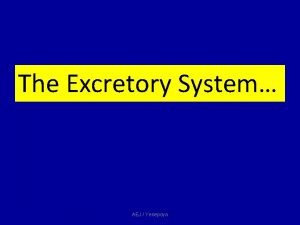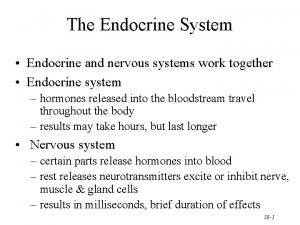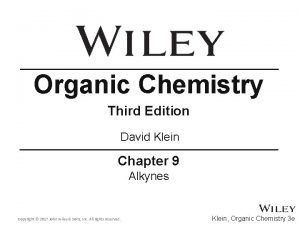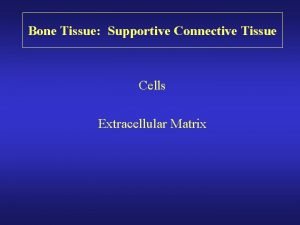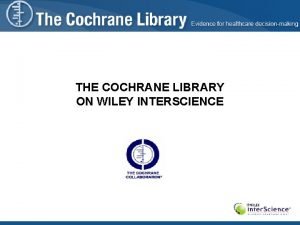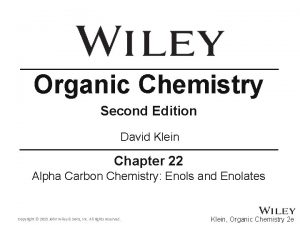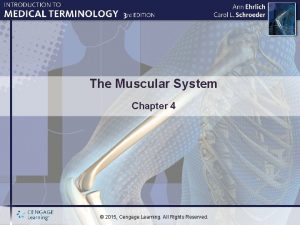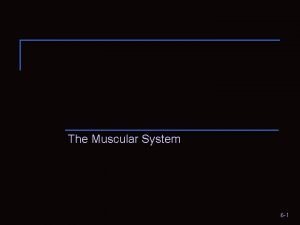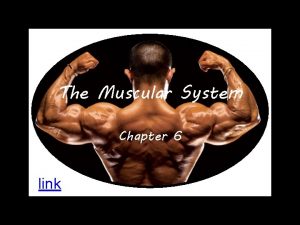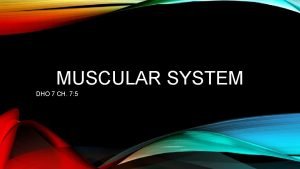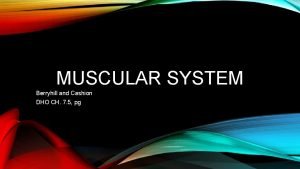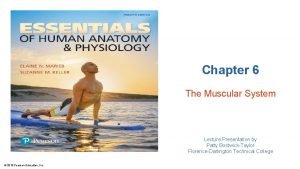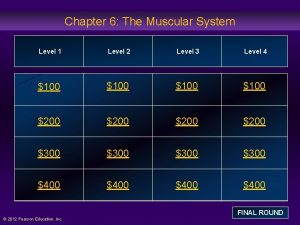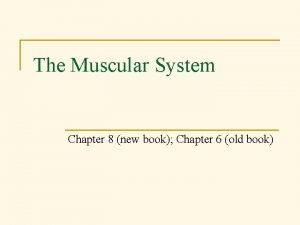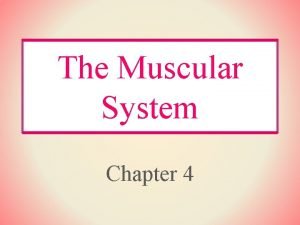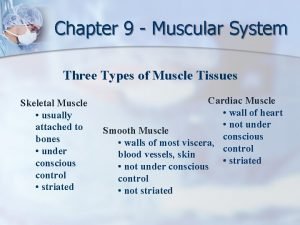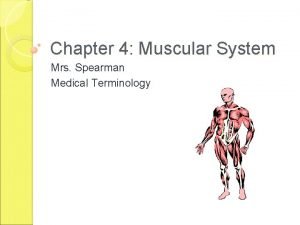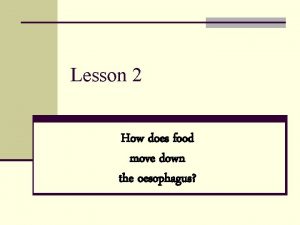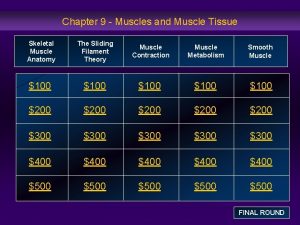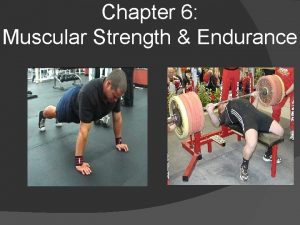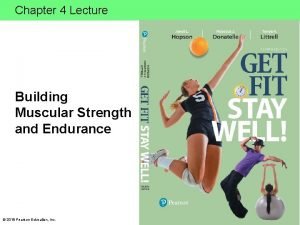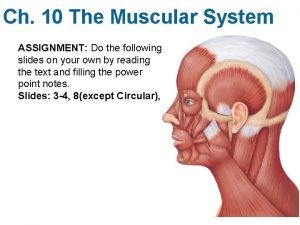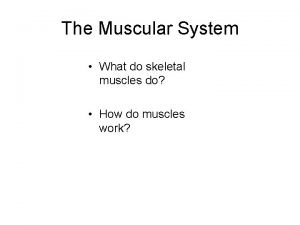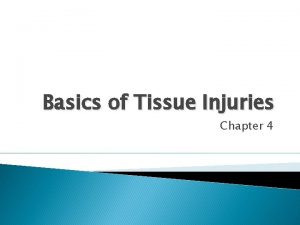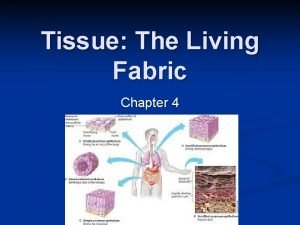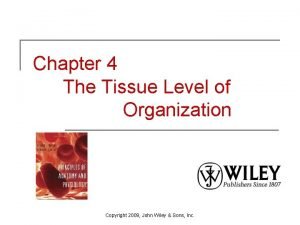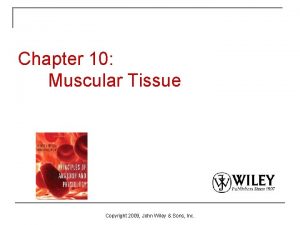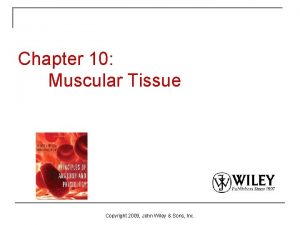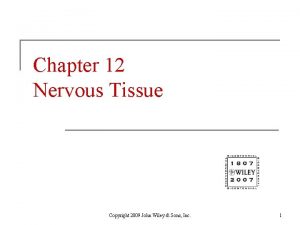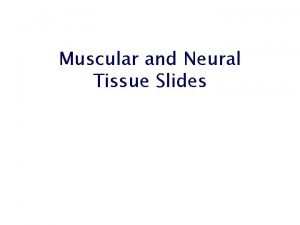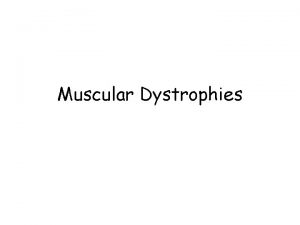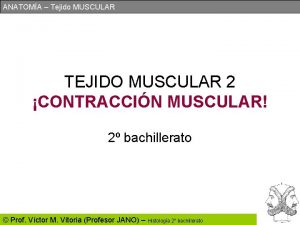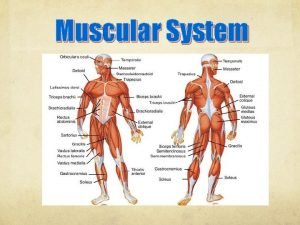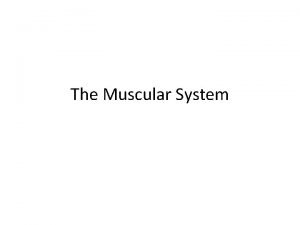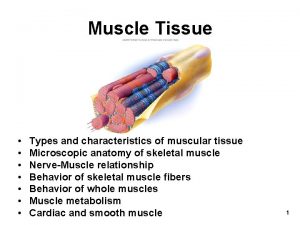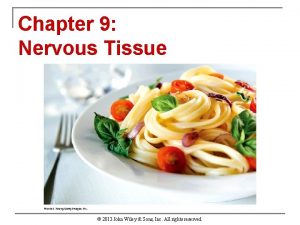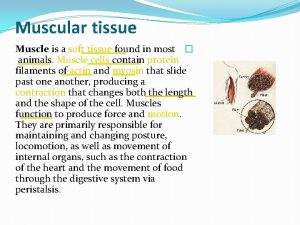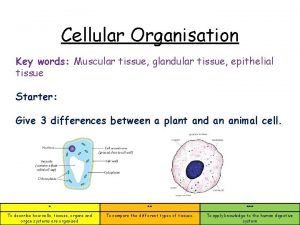Chapter 10 Muscular Tissue Copyright John Wiley and

































































- Slides: 65

Chapter 10 Muscular Tissue Copyright © John Wiley and Sons, Inc. All rights reserved.

Functions of Muscular Tissue Like nervous tissue, muscles are excitable or "irritable” they have the ability to respond to a stimulus Unlike nerves, however, muscles are also: Contractible (they can shorten in length) Extensible (they can extend or stretch) Elastic (they can return to their original shape) Copyright © John Wiley and Sons, Inc. All rights reserved.

Functions of Muscular Tissue Muscle makes up a large percentage of the body’s weight Their main functions are to: Create motion – muscles work with nerves, bones, and joints to produce body movements Stabilize body positions and maintain posture Store substances within the body using sphincters Move substances by peristaltic contractions Generate heat through thermogenesis Copyright © John Wiley and Sons, Inc. All rights reserved.

Three Types of Muscular Tissue Location Skeletal skeleton Cardiac heart Visceral (smooth muscle) G. I. tract, uterus, eye, blood vessels Function movement, heat, posture Appearance Control striated, multinucleated (eccentric), voluntary fibers parallel pump blood striated, one central continuously nucleus involuntary Peristalsis, blood pressure, no striations, one pupil size, central nucleus involuntary erects hairs Copyright © John Wiley and Sons, Inc. All rights reserved.

Three Types of Muscular Tissue (a) Skeletal muscle (b) Cardiac muscle (c) Visceral smooth muscle Copyright © John Wiley and Sons, Inc. All rights reserved.

Skeletal Muscle Location Skeletal skeleton Cardiac heart Visceral (smooth muscle) G. I. tract, uterus, eye, blood vessels Function movement, heat, posture Appearance Control striated, multinucleated, fibers voluntary parallel pump blood striated, one central continuously nucleus involuntary Peristalsis, blood pressure, no striations, one pupil size, central nucleus involuntary erects hairs Copyright © John Wiley and Sons, Inc. All rights reserved.

Skeletal Muscle Copyright © John Wiley and Sons, Inc. All rights reserved.

Skeletal Muscle Skeletal muscle fibers are very long “cells” - next to neurons (which can be over a meter long), perhaps the longest in the body The Sartorious muscle contains single fibers that are at least 30 cm long A single skeletal muscle fiber Copyright © John Wiley and Sons, Inc. All rights reserved.

Skeletal Muscle The terminal processes of a motor neuron in close proximity to the sarcolemma of a skeletal muscle fiber Motor neuron Sarcolemma Copyright © John Wiley and Sons, Inc. All rights reserved.

Organization of Muscle Tissue The epimysium, perimysium, and endomysium all are continuous with the connective tissues that form tendons and ligaments (attach skeletal muscle to bone) and muscle fascia (connect muscles to other muscles to form groups of muscles) Copyright © John Wiley and Sons, Inc. All rights reserved.

Organization of Muscle Tissue Epimysium Perimysium Organization of a single muscle belly Copyright © John Wiley and Sons, Inc. All rights reserved.

Organization of Muscle Tissue Organization of a fasciculus Copyright © John Wiley and Sons, Inc. All rights reserved.

Organization of Muscle Tissue Organization of a muscle fiber Copyright © John Wiley and Sons, Inc. All rights reserved.

Organization of Muscle Tissue A muscle, a fasciculus, and a fiber all visualized Copyright © John Wiley and Sons, Inc. All rights reserved.

Organization of Muscle Tissue In groups of muscles the epimysium continues to become thicker, forming fascia which covers many muscles This graphic shows the fascia lata enveloping the entire group of quadriceps and hamstring muscles Copyright © John Wiley and Sons, Inc. All rights reserved.

Organization of Muscle Tissue Many large muscle groups are encased in both a superficial and a deep fascia Real Anatomy, John Wiley and Sons Copyright © John Wiley and Sons, Inc. All rights reserved.

Organization of Muscle Tissue An aponeurosis is Epicranial aponeurosis essentially a thick Frontal belly of the occipitofrontalis m. fascia that connects two muscle bellies. This epicranial aponeurosis connects the muscle bellies of the occipitalis and the frontalis to form “one” muscle: The occipitofrontalis Copyright © John Wiley and Sons, Inc. All rights reserved.

The Skeletal Muscle Fiber Beneath the connective tissue endomysium is the plasma membrane (called the sarcolemma) of an individual skeletal muscle fiber The cytoplasm (sarcoplasm) of skeletal muscle fibers is chocked full of contractile proteins arranged in myofibrils Copyright © John Wiley and Sons, Inc. All rights reserved.

The Skeletal Muscle Fiber Increasing the level of magnification, the myofibrils are composed of filaments Thick filaments Thin filaments Copyright © John Wiley and Sons, Inc. All rights reserved.

The Skeletal Muscle Fiber The basic functional unit of skeletal muscle fibers is the sarcomere: An arrangement of thick and thin filaments sandwiched between two Z discs A scanning electron micrograph of a sarcomere Copyright © John Wiley and Sons, Inc. All rights reserved.

The Skeletal Muscle Fiber Muscle contraction occurs in the sarcomeres The “Z line” is really a Z disc when considered in 3 dimensions. A sarcomere extends from Z disc to Z disc. Copyright © John Wiley and Sons, Inc. All rights reserved.

Muscle Proteins Myofibrils are built from three groups of proteins Contractile proteins generate force during contraction Regulatory proteins help switch the contraction process on and off Structural proteins keep the thick and thin filaments in proper alignment and link the myofibrils to the sarcolemma and extracellular matrix Copyright © John Wiley and Sons, Inc. All rights reserved.

Muscle Proteins The thin filaments are comprised mostly of the structural protein actin, and the thick filaments are comprised mostly of the structural protein myosin However, in both types of filaments, there also other structural and regulatory proteins Copyright © John Wiley and Sons, Inc. All rights reserved.

Muscle Proteins In the thin filaments actin proteins are strung together like a bead of pearls In the thick filaments myosin proteins look like golf clubs bound together Copyright © John Wiley and Sons, Inc. All rights reserved.

Muscle Proteins In this first graphic, the myosin binding sites on the actin proteins are readily visible. The regulatory proteins troponin and tropomyosin have been added to the bottom graphic: The myosin binding sites have been covered Copyright © John Wiley and Sons, Inc. All rights reserved.

Muscle Proteins In this graphic the troponin-tropomyosin complex has slid down into the “gutters” of the actin molecule unblocking the myosin binding site Myosin binding site exposed The troponin-tropomyosin complex can slide back and forth depending on the presence of Ca 2+ Copyright © John Wiley and Sons, Inc. All rights reserved.

Muscle Proteins Ca 2+ binds to troponin which changes the shape of the troponin-tropomyosin complex and uncovers the myosin binding sites on actin Copyright © John Wiley and Sons, Inc. All rights reserved.

Muscle Proteins Besides contractile and regulatory proteins, muscle contains about a dozen structural proteins which contribute to the alignment, stability, elasticity, and extensibility of myofibrils Titin is the third most plentiful protein in muscle, after actin and myosin - it extends from the Z disc and accounts for much of the elasticity of myofibrils Dystrophin is discussed later as it relates to the disease of muscular dystrophy Copyright © John Wiley and Sons, Inc. All rights reserved.

The Sliding-Filament Mechanism With exposure of the myosin binding sites on actin (the thin filaments)—in the presence of Ca 2+ and ATP—the thick and thin filaments “slide” on one another and the sarcomere is shortened Copyright © John Wiley and Sons, Inc. All rights reserved.

The Sliding-Filament Mechanism The “sliding” of actin on myosin (thick filaments on thin filaments) can be broken down into a 4 step process Copyright © John Wiley and Sons, Inc. All rights reserved.

Step 1: ATP hydrolysis Step 2: Attachment Copyright © John Wiley and Sons, Inc. All rights reserved.

Step 3: Power Stroke Step 4: Detachment Copyright © John Wiley and Sons, Inc. All rights reserved.

The Sliding-Filament Mechanism Copyright © John Wiley and Sons, Inc. All rights reserved.

Length-Tension Relationship Sarcomere shortening produces tension within a muscle Compressed thick filaments Limited contact between actin and myosin Copyright © John Wiley and Sons, Inc. All rights reserved.

Neuromuscular Junction Excitation-Contraction coupling (EC coupling) involves events at the junction between a motor neuron and a skeletal muscle fiber Copyright © John Wiley and Sons, Inc. All rights reserved.

Neuromuscular Junction An enlarged view of the neuromuscular junction The presynaptic membrane is on the neuron while the postsynaptic membrane is the motor end plate on the muscle cell. The two membranes are separated by a space, or “cleft” Copyright © John Wiley and Sons, Inc. All rights reserved.

Copyright © John Wiley and Sons, Inc. All rights reserved.

Neuromuscular Junction Conscious thought (to move a muscle) results in activation of a motor neuron, and release of the neurotransmitter acetylcholine (ACh) at the NM junction The enzyme acetylcholinesterase breaks down ACh after a short period of time Copyright © John Wiley and Sons, Inc. All rights reserved.

Neuromuscular Junction The plasma membrane on the “far side” of the NMJ belongs to the muscle cell and is called the motor end plate The motor end plate is rich in chemical (ligand) - gated sodium channels that respond to ACh. Another way to say this: The receptors for ACh are on the chemical gated sodium channels on the motor end plate Copyright © John Wiley and Sons, Inc. All rights reserved.

Neuromuscular Junction The chemical events at the NMJ transmit the electrical events of a neuronal action potential into the electrical events of a muscle action potential Copyright © John Wiley and Sons, Inc. All rights reserved.

Muscle Action Potential The muscle action potential is propagated over the surface of the muscle cell membrane (sarcolemma) via voltage (electrical)-gated Na+ and K+ channels Copyright © John Wiley and Sons, Inc. All rights reserved.

Sources of Muscle Energy Aerobic ATP production Stored ATP 3 seconds Energy transferred from stored creatine phosphate 12 seconds Anaerobic glucose use 30 -40 seconds Copyright © John Wiley and Sons, Inc. All rights reserved.

Sources of Muscle Energy Copyright © John Wiley and Sons, Inc. All rights reserved.

Skeletal Muscle Metabolism In a state of homeostasis, muscle use of O 2 and nutrients is balanced by the production of manageable levels of waste products like CO 2 Heat - 70 -80% of the energy used by muscles is lost as heat - muscle activity is important for maintaining body temperature Lactic acid (anaerobic) Copyright © John Wiley and Sons, Inc. All rights reserved.

Skeletal Muscle Metabolism Oxygen Debt, or "Excess Post-Exercise Oxygen Consumption" (EPOC) is the amount of O 2 repayment required after exercise in skeletal muscle to: Replenish ATP stores Replenish creatine phosphate Convert lactic acid back into pyruvic acid so it can be used in the Krebs cycle to replenish ATP Copyright © John Wiley and Sons, Inc. All rights reserved.

Skeletal Muscle Metabolism Copyright © John Wiley and Sons, Inc. All rights reserved.

Cardiac and Smooth Muscle Metabolism In response to a single AP, cardiac muscle contracts 10 -15 times longer than skeletal muscle, and must continue to do so, without rest, for the life of the individual To meet this constant demand, cardiac muscle generally uses the rich supply of O 2 delivered by the extensive coronary circulation to generate ATP through aerobic respiration Copyright © John Wiley and Sons, Inc. All rights reserved.

Cardiac and Smooth Muscle Metabolism Like cardiac muscle, smooth muscle (in your deep organs) is autorhythmic and is not under voluntary control (your heart beats and your stomach digests without you thinking about it). Unlike cardiac (and skeletal muscle) however, smooth muscle has a low capacity for generating ATP and does so only through anaerobic respiration. Copyright © John Wiley and Sons, Inc. All rights reserved.

The Motor Unit is composed of a motor neuron plus all of the muscle cells it innervates § High precision • Fewer muscle fibers per neuron • Laryngeal and extraocular muscles (2 -20) § Low precision • Many muscle fibers per neuron • Thigh muscles (2, 000 -3, 000) Copyright © John Wiley and Sons, Inc. All rights reserved.

The Motor Unit Florescent dye is used to show the terminal processes of a single neuron which terminate on a few muscle fibers Copyright © John Wiley and Sons, Inc. All rights reserved.

The Motor Unit Activities requiring extreme precision (like the subtle and rapid movements of the eye) involve muscles with very small motor units (1 -4 muscle fibers/neuron) Copyright © John Wiley and Sons, Inc. All rights reserved.

The Motor Unit All-or-none principle of muscle contraction When an individual muscle fiber is stimulated to depolarization, and an action potential is propagated along its sarcolemma, it must contract to it’s full force— it can’t partially contract Also, when a single motor unit is recruited to contract, all the muscle fibers in that motor unit must all contract at the same time Copyright © John Wiley and Sons, Inc. All rights reserved.

Skeletal Muscle Fiber Types Skeletal muscle fibers are not all alike in appearance or function. By appearance: Red muscle fibers (the dark meat in chicken legs) have a high myoglobin content, more mitochondria, more energy stores, and a greater blood supply White muscle fibers (the white meat in chicken breasts) have less myoglobin, mitochondria, and blood supply Copyright © John Wiley and Sons, Inc. All rights reserved.

Skeletal Muscle Fiber Types Slow oxidative fibers (SO) are small, appear dark red, are the least powerful type. They are very fatigue resistant Used for endurance like running a marathon Fast oxidative-glycolytic fibers (FOG) are intermediate in size, appear dark red, and are moderately resistant to fatigue. Used for walking Fast glycolytic fibers (FG) are large, white, and powerful Suited to intense anaerobic activity of short duration Copyright © John Wiley and Sons, Inc. All rights reserved.

Skeletal Muscle Fiber Types Copyright © John Wiley and Sons, Inc. All rights reserved.

Skeletal Muscle Fiber Types Most skeletal muscles are a mixture of all three types of skeletal muscle fibers; about half the fibers in a typical skeletal muscle are slow oxidative (SO) fibers Within a particular motor unit all the skeletal muscle fibers are the same type The different motor units in a muscle are recruited in a specific order depending on the task being performed (fast anaerobic activity for maximal force, etc. ) Copyright © John Wiley and Sons, Inc. All rights reserved.

Tension in a Muscle There is a brief delay called the latent period as the AP sweeps over the sarcolemma and Ca 2+ ions are released from the sarcoplasmic reticulum (SR) During the next phase the fiber is actively contracting This is followed by relaxation as the Ca 2+ ions are resequestered into the SR and myosin binding sites are covered by tropomyosin Temporary loss of excitability is call the refractory period – All muscle fibers in a motor unit will not respond to a stimulus during this short time Copyright © John Wiley and Sons, Inc. All rights reserved.

Tension in a Muscle Applying increased numbers of action potentials to a muscle fiber (or a fascicle, a muscle, or a muscle group) results in fusion of contractions (tetanus) and the performance of useful work Copyright © John Wiley and Sons, Inc. All rights reserved.

Tension in a Muscle Two motor units, one in green, the other in purple, demonstrate the concept of progressive activation of a muscle known as recruitment Recruitment allows a muscle to accomplish increasing gradations of contractile strength Copyright © John Wiley and Sons, Inc. All rights reserved.

Muscle Contraction Isotonic contractions result in movement Concentric isotonic is a type of muscle contraction in which the muscles shorten while generating force Eccentric isotonic is a contraction in which muscle tension is less than the resistance (the muscle lengthens) Isometric contractions result in no movement Muscle force and resistance are equal Supporting objects in a fixed position and posture Copyright © John Wiley and Sons, Inc. All rights reserved.

Muscle Contraction Copyright © John Wiley and Sons, Inc. All rights reserved.

Imbalances of Homeostasis Exercise-induced muscle damage After intense exercise electron micrographs reveal considerable muscle damage including torn sarcolemmas and disrupted Z-discs Blood levels of proteins normally confined only to muscle (including myoglobin) increase as they are released from damaged muscle Copyright © John Wiley and Sons, Inc. All rights reserved.

Imbalances of Homeostasis Spasm A sudden involuntary contraction of a single muscle within a large group of muscles – usually painless Cramp Involuntary and often painful muscle contractions Caused by inadequate blood flow to muscles (such as in dehydration), overuse and injury, and abnormal blood electrolyte levels Copyright © John Wiley and Sons, Inc. All rights reserved.

Imbalances of Homeostasis Disease States and Disorders Fibrosis (myofibrosis) § Replacement of muscle fibers by excessive amounts of connective tissues (fibrous scar tissue) Myosclerosis § Hardening of the muscle caused by calcification Both myosclerosis and muscle fibrosis occur as a result of trauma and various metabolic disorders Copyright © John Wiley and Sons, Inc. All rights reserved.

Imbalances of Homeostasis Aging In part due to decreased levels of physical activity, with aging humans undergo a slow, progressive loss of skeletal muscle mass that is replaced largely by fibrous connective tissue and adipose tissue Muscle strength at 85 is about half that at age 25 Compared to the other two fiber types, the relative number of slow oxidative fibers appears to increase Copyright © John Wiley and Sons, Inc. All rights reserved.
 John wiley and sons
John wiley and sons John wiley & sons
John wiley & sons John wiley & sons
John wiley & sons Chapter 10 muscle tissue
Chapter 10 muscle tissue John wiley & sons, inc.
John wiley & sons, inc. Organic chemistry 2nd edition klein
Organic chemistry 2nd edition klein John wiley
John wiley Plyometrics disadvantages
Plyometrics disadvantages Function of muscular tissue
Function of muscular tissue Thin
Thin Intercellular connections
Intercellular connections How is aerolar tissue different than aerenchyma tissue?
How is aerolar tissue different than aerenchyma tissue? Water reabsorption
Water reabsorption Chapter 36 skeletal muscular and integumentary systems
Chapter 36 skeletal muscular and integumentary systems Chapter 14 lesson 3 the nervous system
Chapter 14 lesson 3 the nervous system Onlinelibrary wiley com
Onlinelibrary wiley com Jean butler genie
Jean butler genie Advanced accounting wiley
Advanced accounting wiley Genie wiley
Genie wiley What do the moors symbolize in wuthering heights
What do the moors symbolize in wuthering heights Kehinde wiley bio
Kehinde wiley bio Management information systems wiley
Management information systems wiley Kehinde wiley barack obama
Kehinde wiley barack obama Sacroiliac bone
Sacroiliac bone Www.interscience.wiley.com
Www.interscience.wiley.com Elbow joint diagram
Elbow joint diagram Keeton v anderson-wiley
Keeton v anderson-wiley Wiley
Wiley Osmoreceptors
Osmoreceptors Wiley
Wiley Alkyne to alkene
Alkyne to alkene Doc praxisklinik im wiley
Doc praxisklinik im wiley Phosphorus equation
Phosphorus equation Wiley
Wiley Cochrane wiley
Cochrane wiley Wiley
Wiley Dorsiflexion word parts
Dorsiflexion word parts Muscular system figure
Muscular system figure The muscular system chapter 6
The muscular system chapter 6 Chapter 6 the muscular system figure 6-12
Chapter 6 the muscular system figure 6-12 7:5 muscular system
7:5 muscular system Chapter 9 muscular system
Chapter 9 muscular system Chapter 32 section 3 the muscular system answer key
Chapter 32 section 3 the muscular system answer key Contractile unit of muscle
Contractile unit of muscle Chapter 7:5 muscular system
Chapter 7:5 muscular system Chapter 6 the muscular system
Chapter 6 the muscular system Chapter 4 the muscular system
Chapter 4 the muscular system Chapter 6 the muscular system
Chapter 6 the muscular system Chapter 6 the muscular system
Chapter 6 the muscular system Muscles that have their fasciculi arranged like barbs
Muscles that have their fasciculi arranged like barbs Chapter 8 the muscular system
Chapter 8 the muscular system The muscular system chapter 4
The muscular system chapter 4 Active muscles
Active muscles Dyskinesia is the distortion or impairment of:
Dyskinesia is the distortion or impairment of: A long and narrow muscular tube that relaxes and contracts
A long and narrow muscular tube that relaxes and contracts Chapter 14 bleeding shock and soft tissue injuries
Chapter 14 bleeding shock and soft tissue injuries Muscles and muscle tissue chapter 9
Muscles and muscle tissue chapter 9 Fitt chart
Fitt chart Venn diagram of muscular strength and endurance
Venn diagram of muscular strength and endurance Muscular system assignment
Muscular system assignment Major skeletal muscles
Major skeletal muscles Skeletal and muscular system
Skeletal and muscular system Chapter 4 the tissue level of organization
Chapter 4 the tissue level of organization Chapter 4 basics of tissue injuries
Chapter 4 basics of tissue injuries Chapter 4 tissue the living fabric
Chapter 4 tissue the living fabric Chapter 4 the tissue level of organization
Chapter 4 the tissue level of organization
